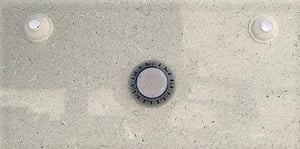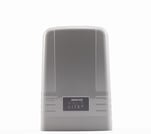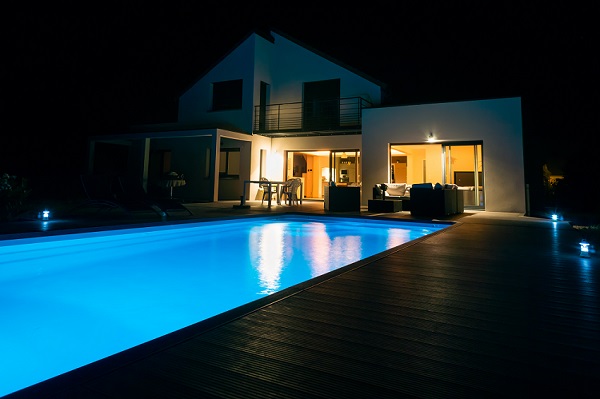Pool Lights - The Best Ways To Light Your DIY Pool
A pool light for your DIY pool is essential. The right placement of your pool light/s also makes a big difference to how your pool will look at night and how many lights you will need. Pool lights are as much about safe night swimming as it is about making your pool an awesome visual treat at night. Let's dive into (yep, pun intended!) your pool lighting options, the pro's, con's and costs.
WHAT TYPE OF POOL LIGHTS ARE THERE?
There are two main types of pool lights for your DIY pool - Halogen and LED
Halogen lights, like plastic straws and plastic bags, are on the way out as a pool lighting option. They are power hungry, vulnerable to corrosion and the filament globe needs replacing every 2,500 hours. The globes are relatively inexpensive to buy however they can be fiddly to replace. The biggest limitation with halogen pool lights is they only produce one colour - bright white that can have a green hue due to the light producing filament inside the globe.
Light emitting diode (LED) pool lighting has soared in popularity over the past 5 years, and DIY pool owners almost unanimously install LED for several reasons – they are highly energy efficient (up to 80% less power use compared to a halogen), they are compact, and they can change all sorts of colours depending on the look you want for that particular day. You can also adjust the colour hue and brightness depending on the brand. It is like Christmas lights for your pool as the light output is brighter and more vibrant than halogen light.
LED pool light globes have a very long operating life (over 45,000 hours). You can opt for flush mounted LEDs where only the front face of the light is visible. Or, you can go for surface mounted LEDs (as shown) where the globe and surrounding mount plate are visible. It is a personal preference, and there is no difference in effectiveness with either option.

LED pool lights cost between $300 and $750 each, plus the cost of a transformer (around $180).
If you can part with that upfront, you will have a set-and-forget light fitting, offering a rainbow of colour settings without the hassle of globe replacement and low operating costs. A quality brand will offer a two year warranty on your LED pool light. Looking at one of those "wow, that's so cheap" LED lights on eBay? Do your homework on who offers the warranty, not just the length. Also, check the unit size. They are often 25cm to 30cm in diameter (the size of a frisbee).
Full disclosure – we do not sell halogen lights. We think it is like selling horses when cars first started on the roads. We do sell retrofit LED kits if you want to replace your horse; we mean halogen light, however.
The following tips apply to all pool lights; however with almost all pool lights sold today being LED, I might lean towards LED's a little more, given that this is what pool owners are mainly buying.
DO YOU KNOW IF LED POOL LIGHTS ARE SAFE?
Which usually means, "Will I electrocute anyone with one of these lights in my pool?" LED pool lights need a small power transformer to convert 240-volt electricity into 12-volt electricity. What does this mean? The transformer plugs straight into a standard power point. The LED pool light plugs into the transformer, reducing the voltage from 240 to 12, which is all a LED light needs. If you think of a 12-volt battery that powers a personal torch, there isn't any risk of electrocution-fitting an LED light to your DIY pool.
COULD YOU LET ME KNOW HOW MANY LED POOL LIGHTS I NEED?
The most crucial part of pool lighting is ensuring your pool is safe for night swimming, which means entry steps are fully illuminated, and the whole pool is visible. The second part is how much of a feature you want your pool to be. Like drinking wine, more is not always better. Generally, anything more than 3 or 4 pool lights and planes might start using your extremely well-lit pool as a nighttime navigation marker!
If your pool is over 7m long and rectangular, the consensus is that a minimum of 2 lights are needed to have consistent light across your collection. Darker-coloured pools will absorb more light than a lighter colour, requiring a second pool light if your DIY pool is less than 7m long.
If you live in a rural area without ambient lighting from street lights and buildings, you may need the extra oomph of 3 pool lights if you have a 9m+ pool. If you have an L-shaped DIY pool, side entry steps or a kidney-shaped pool, it is essential to ensure edges or curves do not obscure your pool lights, as this will create dark areas in your collection.
WHERE SHOULD YOU POSITION YOUR POOL LIGHT?
Think about where you will mainly look at your pool - from the deck, kitchen window or patio. You can always position your pool light/s to shine away from this area. If you have a seating area in your pool, could you apply the same thinking? Looking straight into pool lights is both dazzling (think looking into headlights) and makes it harder to appreciate the stunning feature that your DIY pool is at night time.
Most LED pool lights come with a two-output transformer, which means you can connect two LED lights to it. Similarly, a four-output transformer can run four LED lights, so you don't need a transformer for each morning. From a pure cost perspective, the further your lights are from a power source, the more expensive it will be for an electrician to install a PowerPoint. The closer to your DIY pool, the better; however, don't let an additional $100 for an electrician compromise having your pool adequately lighted and looking sensational.
Okay, so you've worked out the location. What do you think about the height of the light that should be installed in your pool? Most manufacturers recommend installing your pool light 400mm below the water line; however, you can put the light wherever you want.
DO YOU KNOW IF LED POOL LIGHTS ARE EASY TO OPERATE?
The simple answer is "Yes". You can program and operate them efficiently without needing a PhD in Home Appliances. If you have a standard transformer, you can turn your lights on and off at the power point the transformer is plugged into. You can change colours by clicking the light on and off to the colour you would like (or leave it on an automatic cycle-through mode), and the next time you turn the lights on, it will be the same colour as when you last turned it off. A cheap and easy solution is to buy a digital timer from Bunnings and set the on and off time so your lights turn on and off simultaneously each day.
LED lights with remote controls are another option. The remote controls work like a garage door remote - point-and-shoot with limited range. They are not particularly waterproof, and a decent number of remotes have gone to remote control heaven after a swim or being dropped by the kids. If remote controlling your pool lights is a must, it might be better to stretch the budget by $200 and buy a light controller rather than a standard transformer.
swim or being dropped by the kids. If remote controlling your pool lights is a must, it might be better to stretch the budget by $200 and buy a light controller rather than a standard transformer.
Light controllers are part transformer and part Bluetooth remote controller operated from an app on your smartphone. The app will allow you to change the colours and set the schedules for turning on and off your lights. You can retrofit a controller whenever asity plugs into your wall like a transformer.
SURELY THERE MUST BE LIMITATIONS TO LED POOL LIGHTS?
Yes, there sure is. We've already talked about the higher upfront cost. An operating life of up to 45,000 hours sounds fantastic, right? However, that is the globe itself. The entire unit will live in chlorinated water, breaking down the plastics and seals over time. LED lights are not repairable, so if the team leaks, it needs a complete replacement. The simple summary is that the team will fail before the globe; however, you will still get many years from the light before this happens.
Related Blogs
In the height of a Perth summer, the idea of stepping into a backyard pool feels more like a necessity than a luxury. However, for many Western Australian homeowners, there's a nagging concern that....
The New Heart of the Home Is Outside A growing number of Australians are redesigning their backyards, not as utility spaces, but for lazy weekends, summer dinners, and somewhere the kids can burn....
Choosing the perfect pool size isn’t as straightforward as it sounds. Sure, it’s tempting to go as big as your backyard allows, but that’s not always the smartest choice—especially when you factor in....
About The Author
My wife and I grew up playing in swimming pools. Our daughters learnt to swim in our backyard fibreglass swimming pool. There is nothing quite like hearing kids splashing about and giggling. As pools do, our pool became a social magnet for friends, family and neighbours which we loved. Helping customers to have their own pool and saving customers thousands on their pool and equipment is the best job in the world.
























